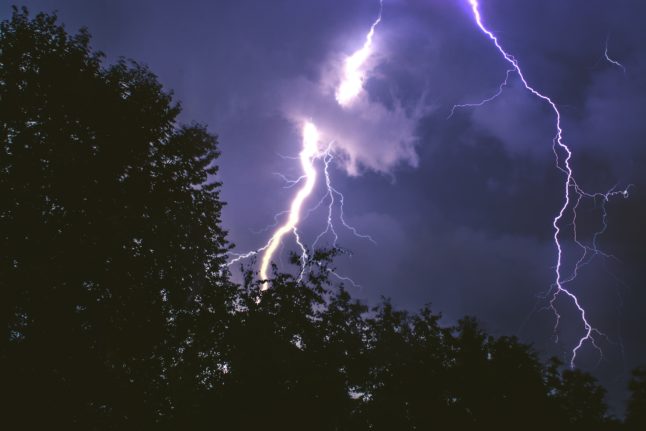Storms are a regular occurrence in Austria during the summer months, but the strength and frequency seems to be increasing.
Overnight on Tuesday, June 28th, both the Pöllinger and the Treffner rivers in Carinthia burst their banks causing widespread flooding, mudslides and damage across the region.
READ ALSO: Who to call and what to say in an emergency in Austria
Schlimme Bilder aus #Arriach in #Kärnten, welches heute Nacht von mehreren Unwetterzellen getroffen wurde. Der Ort ist derzeit lt. ORF von der Außenwelt abgeschnitten und nicht durch die Einsatzkräfte erreichbar
©️ Mario Kornberger @Kachelmannwettr @manu_bx @alpen_wetter pic.twitter.com/iLrZ7b2a3N
— Unwetter-Freaks (@unwetterfreaks) June 29, 2022
A Tweet from Unwetter-Freaks said: “Bad pictures from #Arriach in #Kärnten , which was hit by several storm cells last night. According to ORF, the place is currently cut off from the outside world and cannot be reached by the emergency services.”
READ ALSO: 23 essential articles to help you navigate life in Austria
In July, storms in Carinthia and Tirol caused some €6 million in damages as crews struggle with clean-up work after the severe rains, Der Standard reported. In Vienna and surrounding regions, there were alerts for extreme weather as winds picked up speed and the rain also caused damages.
Gab in der Nach "leichten" Hagel bei uns O.o pic.twitter.com/lhcUVgtQvw
— Patrick #FF8Vorfreude 😀 (@FableFreewar) June 28, 2022
With the summer season far from over and the possibility of more wild weather in the coming months, here’s how to stay safe during storms in Austria.
FOR MEMBERS: When and where to avoid driving in Austria this summer
Check the weather report
It might sound obvious, but checking the weather forecast should be at the top of the list of summer storm preparations.
Unlike in the past, weather reports are now typically reliable, and apps like Bergfex and Accuweather are well-known for providing detailed forecasts and weather warnings.
However, long-range forecasts can change quickly, so if you’re planning a camping or hiking trip, be sure to check the weather between 24 and 48 hours before to avoid being caught out.
Additionally, the Österreichischen Unwetterzentrale (Austrian Severe Weather Centre) has regular updates about storms and weather forecasts for Austria and users can sign up for email and SMS notifications.
Stay indoors
According to the organisation, Die Helfer Wiens (The Helpers of Vienna) one of the biggest risks during a storm is being hit by a fallen tree or flying debris.
For this reason, they advise people (and pets) to stay indoors during a storm and close all windows and doors.
If staying in a tent or campervan, it’s also a good idea to seek shelter in a building (if possible) until the storm has passed.
However, if you are outside during lightning, the Austrian Red Cross says the best approach is to crouch down into a ball to reduce the amount of contact you have with the floor.
READ MORE: How to keep your apartment cool in Austria this summer amid rising energy prices
Stay away from the cellar
Cellars and underground car parks can quickly become flooded during heavy rain – as seen in recent storms in Upper Austria and Carinthia, and last year during violent storms across Austria.
Flash flooding can happen quickly (the clue is in the name), so stay away from cellars and underground spaces during a storm and call the emergency services if you suspect a flood in your home.
Remove plants and furniture from balconies
Having plants and flowers on a balcony is a lovely way to brighten up an outside space, but they risk being damaged during a storm.
To safeguard your pots and lovingly-planted flora, move them inside – especially during a thunderstorm with strong wind gusts and lightning.
The same applies to any outdoor furniture that could be damaged by wind or hail, like cushions, decorative objects and sun umbrellas.
Park cars under shelter
Hail is one of the leading causes of dents to bodywork on cars and damage to windscreens, both of which can be costly to repair.
If hail is forecast during a storm, park a car in a garage or under shelter, if possible.
If strong wind is expected, then avoid parking a car under trees as debris, or even the tree itself, could end up landing on the vehicle.
FOR MEMBERS: EXPLAINED: How Austria banned everyone from the forest for 123 years
Don’t go into the forest
Whether walking or driving, the best advice is to stay from the forest or areas with lots of trees during a storm.
While sheltering under a tree can protect from rain or hail, lightning or strong wind can bring down trees. This makes the forest a dangerous place to be in a storm.
But if you do find yourself in the unfortunate position of being in a forest when a thunderstorm hits, stay away from low branches and tree trunks and crouch down low. Place any walking sticks or metal poles away from you and stay away from metal fences.
Avoid risky activities
Certain outdoor activities are especially hazardous if there’s a lightning storm.
Any activity in an open area or that puts you into contact with water or metal is strongly advised against. So that means fishing, swimming, boating, cycling and golfing are out until the storm is over.
Keep torches and candles ready
Power cuts are common during storms, so keep a stock of candles and torches ready in case you end up without electricity for several hours.
It’s also a good idea to have a portable USB charger to make sure your phone doesn’t run out of battery during an emergency.
Who to call in an emergency
These are the numbers to call if you need help from the Austrian emergency services during a storm.
122 – fire service (Feuerwehr).
133 – police (Polizei).
144 – ambulance (Krankenwagen or Rettungswagen).
120 – ÖAMTC emergency breakdown service.
123 – ARBÖ emergency breakdown service.
140 – mountain rescue.
Finally, 112 is the single European emergency number, whose operators will direct you to the relevant services. This number can even be called on a locked mobile phone without needing the pin.
Find out more with The Local’s guide on who to call and what to say in an emergency.



 Please whitelist us to continue reading.
Please whitelist us to continue reading.
Member comments